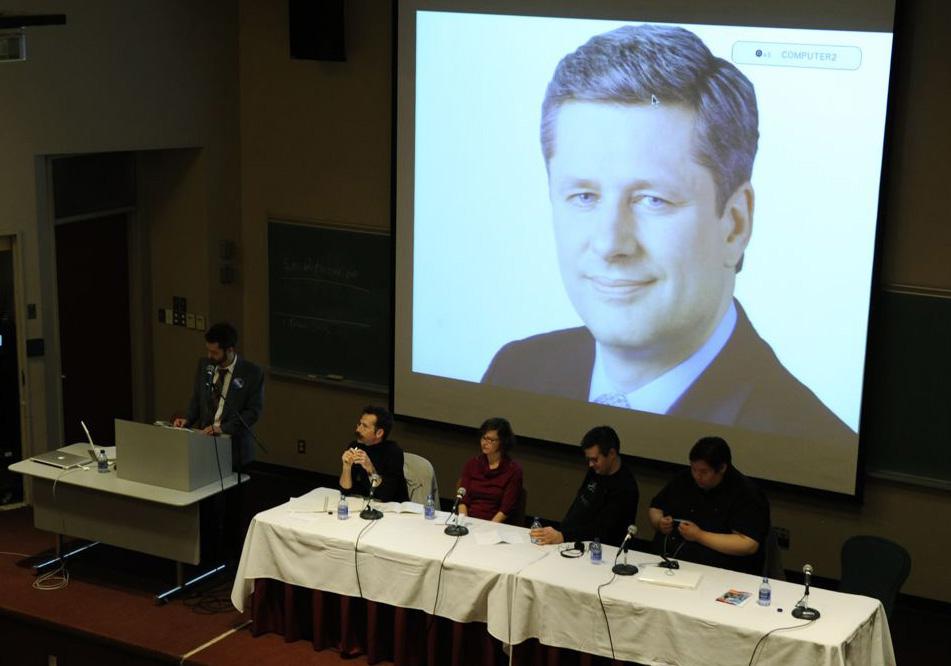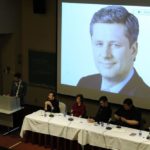This makes it a perfect time to take a step back and assess not only the legacy of artist-run culture in Canada, but more importantly its possible future. That’s exactly what was on the agenda at this past weekend’s Hot Buttons conference, a national gathering organized by Artist-Run Centres & Collectives of Ontario.
With keynote presentations by artists Paul Butler and Germaine Koh, both of whom have developed international reputations based on artist-run beginnings, and a full slate of panel discussions led by some of the current main players in the ARC system, the conference managed to touch on all of the standing issues—funding challenges, generational/ideological/educational divides and the crucial importance of audience development and public engagement among them. Even the critical language used to frame these discussions was up for debate.
There were many key points and ideas raised and no doubt heated discussion ensued outside of the conference room, which is, after all, half the point (and fun) of getting artists and art professionals together in a national caucus.
But the conference’s most promising panels also proved to be its most unresolved. The opening panel “Artist-Run Culture in an Age of Endless Distraction” was set to examine the prospect of ARC marginalization in an era dominated by mass entertainment culture. This may be a difficult or arguably false cultural opposition to consider, but it does raise an important question: Do ARCs need to become more institutionalized to compete or is there still room for risk taking without compromise? It’s a very real issue and one that strikes at the core mandates and future livelihoods of ARCs. While panellists recognized the need for ARCs to “re-articulate” their purpose as sites for learning, research and development, the discussion never gained enough momentum to finish with concrete ideas. Most telling was a comment that perhaps long-term planning is “an anathema” to artist-run thinking.
The weekend’s final panel, “The Future of Artist-Run Culture: What will an Artist-Run Centre look like in 15 years?”, was also naggingly inconsistent. Fredericton-based artist and Third Space Gallery director Chris Lloyd projected a rather bleak ARC future in 2023 in tandem with a record-breaking 17-year prime ministerial run by Stephen Harper. It was half-serious food for thought. Or Gallery’s Jonathan Middleton did well to point forward to some innovative, alternative artist-run modelling from the grand historical scale of the Vienna Secession to the locally engaged spontaneity of Vancouver artist Kristina Lee Podesva’s colourschool project. But the most surprising and perhaps problematic example came from artist and Eyelevel Gallery director Eryn Foster. Citing the day-to-day drain of administrative pressures at the Halifax ARC, Foster plans to return the gallery and office routine to its 1974 beginnings for one month—typewriter, rotary dial phone and all. It’s an experiment in “unplugging” from the distractions of email and Internet to make real time for artists and audiences. The conference crowd applauded this Luddite affirmation that less is more. But it seems, from all of the weekend’s proceedings, that the future for ARCs lies not in disengaging but in re-engaging, not unplugging but plugging in, not responding to the past but looking ahead to the future. ARCs need to once again break from the predictable and embrace the unexpected. Take, for example, Artspeak (one of the country’s leading ARCs) and its recent move away from the traditional gallery model to become a research-focused resource centre with off-site exhibition programming. Time, as always, will tell, but one thing is sure—I wouldn’t want to be in Foster’s chair when she opens her Eyelevel email inbox at the end of that month.

 "The Future of Artist-Run Culture" panel at Hot Buttons; from left, Chris Lloyd, Douglas Scholes, Eryn Foster, Jonathan Middleton and Elwood Jimmy / photo © Gary Hall
"The Future of Artist-Run Culture" panel at Hot Buttons; from left, Chris Lloyd, Douglas Scholes, Eryn Foster, Jonathan Middleton and Elwood Jimmy / photo © Gary Hall








